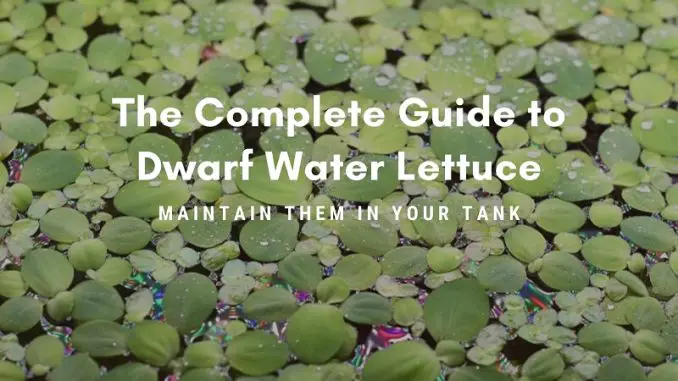
Dwarf water lettuce actually bears no relation to actual lettuce; it gets its name because its appearance is similar to lettuce. Dwarf lettuce is also called Nile lettuce or water lettuce, even though it’s not actual lettuce, either.
In actuality, Dwarf water lettuce is a floating aquatic plant. Like most things in life, Dwarf water lettuce is both a blessing and a curse. It has a number of beneficial qualities, but left unchecked can take over your aquarium.
Dwarf water lettuce provides shade to help smaller creatures in your tank such as newborn fish fry and baby shrimp and absorbs ammonia and nitrate to improve the health of your aquarium.
On the other hand, Dwarf water lettuce (scientific name Pistia stratiotes) is considered by many governments to be, quite frankly, a weed and a menace.
As long as you get the water conditions correct, you should have no problem getting these plants to thrive in your aquarium, as they proliferate rapidly.
Dwarf water lettuce, which is found in myriad aquariums and garden ponds, belongs to the arum family. Read on for information about how to cultivate and control this plant that floats beautifully in your community tank.
Color Form:GreenLifespan: Up to 2 years
Read Related Topic: dwarf lilies
Dwarf Water Lettuce Facts & Overview
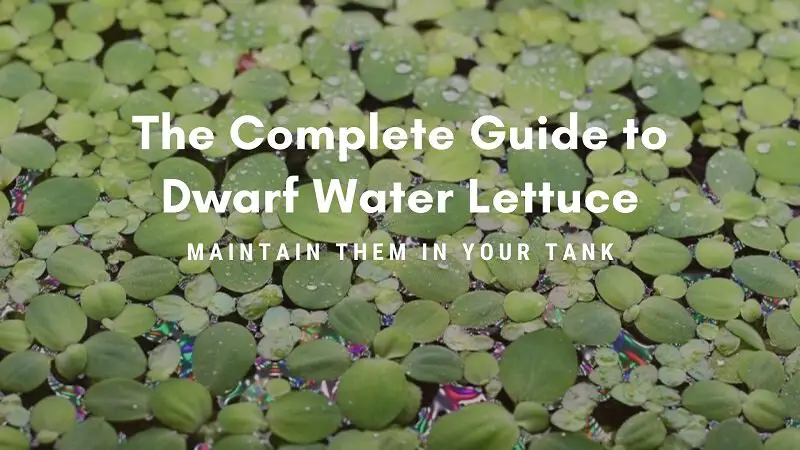
| Category | Rating |
| Care Level: | Moderately difficult |
| Size: | 4 inches - 10 inches maximum |
| Diet: | No fertilizer required/td> |
| Family: | Arum |
| Minimum Tank Size: | 10 gallons |
| Tank Set-Up: | 6.5-7.2 pH, soft to moderately hard water |
| Temperature | 70 to 80 °F (21-27°C) |
| Compatibility: | Threatens some native fish and vegetation |
Dwarf water lettuce lives floats and grows on the water’s surface. Native to the continent of Africa, it was discovered on the Nile River near Lake Victoria. Perhaps that’s where it gets one of its alternate names, Nile lettuce.
Dwarf water lettuce’s scientific name is Pistia stratiotes and botanists in Ancient Greece document its existence about 2,000 years ago. Pistia stratiotes is a tropical floating plant and will grow pretty much anywhere except where there is frost.
Right now, Antarctica is the only place in the world where we don’t see Dwarf water lettuce.
Now, because it grows so well, it sometimes steals space, water, and nutrients from other vegetation and fish. In short, it is considered by many as a pest, and transporting Dwarf water lettuce into certain states and countries is prohibited.
In the U.S., Dwarf water lettuce is considered invasive and therefore illegal in the following states: Alabama, California, Florida, Louisiana, Mississippi, South Carolina, Texas, and Wisconsin. According to records, water lettuce was first identified in the U.S. in the 1700s.
In 2019, Dwarf water lettuce was being considered for inclusion in the EU’s invasive species list, but the UK government blocked the addition of this floating plant. Queensland is just one global example of a state that officially considers it an invasive species.
All that being said, the Dwarf water lettuce is much more likely to be seen in a captive environment like your aquarium or backyard pond, so the chances of it blocking main waterways are slim.
As long as you are keeping an eye on the growth of your Dwarf water lettuce and trimming and maintaining it, you should be able to prevent it from taking over your tank. You should, however, make sure you’re not breaking any laws by bringing this species into the area where you live.
Typical Behavior
As water lettuce goes, the Dwarf water lettuce is more containable in terms of spread. Some people believe that the Dwarf variety results from being in an environment where there are fewer available nutrients, and that’s why it doesn’t spread as much.
Still, left to their own devices, Dwarf water lettuce plants will spread wildly, forming a mat of floating green and roots through your aquarium or outdoor pond. Without containment, they are likely to starve the life out of anything else in your tank.
For that reason, you should clear out a few of the plants every week or so.
If you’re willing to check their behavior, you’ll see that they can use their powers for good rather than evil.
Benefits of Keeping Dwarf Water Lettuce in Your Tank
Shelter and Protection
We mentioned in the introduction that the Dwarf water lettuce provides shade and cover for baby creatures in your aquarium and those that are more introverted and like to hide. Their green cover and long roots that dangle down that tank provide plenty of good hiding places.
Algae Control
On the negative side, the water lettuce’s voracious appetite for nutrients starves vegetation. On the positive side, it keeps algae from running rampant in your aquarium community by consuming its source of food.
Warning: Some of your aquarium residents may rely on the nutrients from algae, like some fish, shrimp, and snails. If you have an abundance of Dwarf water lettuce and a dearth of algae, you may need to supplement with algae wafers.
Cleaning the Gunk
No aquarium enthusiast wants too much nitrate or ammonia in their tank; it’s harmful to your community. The water lettuce absorbs both, creating a healthier aquarium biome; it also encourages the growth of good bacteria. Dwarf water lettuce will also absorb waste and metals that you don’t want in the tank.
Appearance
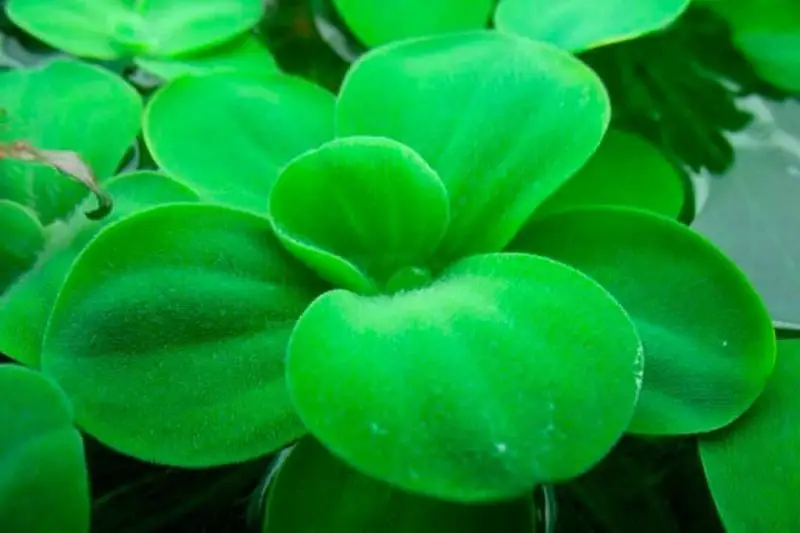
The water lettuce’s name reveals much about its appearance. They do look like wavy-edged lettuce or lettuce with vein patterns that harken back to our popular edible greens.
Pale to yellow-green in color, their leaves are fan-shaped, and together, they look like little rosettes and add a nice touch to your aquarium’s design accent.
How do they float? Air is trapped in the tiny hairs that populate their leaves, and that helps them with flotation.
They have long, stringy roots that travel down through the water of the aquarium. Since they float, you can see the roots, which are either white or black. These roots can be longer than afoot, and serve as private breeding areas for fish.
Decorative Notes
When the Dwarf water lettuce is fertilized, you’ll see berries sticking up. The Nile water lettuce also has flowers that are more difficult to see since they are often masked by the plant’s leaves.
Size
In your home aquarium community, the Dwarf water lettuce usually tops out at about 4 inches (10.2 cm). If you are looking at the plant out in the wild, you might see sizes up to 10 inches (25.4 cm).
Habitat and Tank Conditions
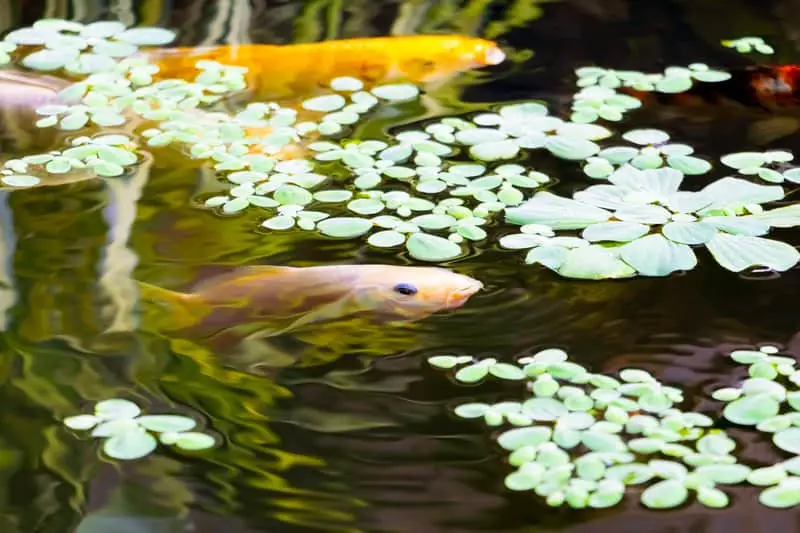
The Dwarf water lettuce is a robust floating plant, but it does need water temperatures of at least 64 to 68 degrees F (17.8 to 20 C). If it is too cold in the tank, the Nile lettuce will not survive. As we discussed before, part of the habitat discussion with the Dwarf water lettuce must include the risk to the rest of the aquarium habitat when the water lettuce is present.
Tank Conditions
Water
We already discussed the minimum temperature; their preferred temperature range is 72 to 86 degrees F (22.2 to 30 C). In terms of pH, Dwarf water lettuce plants do best in the 6.0 to 7.5 range, which is soft to slightly hard water.
Humidity
Dwarf water lettuce depends on a high humidity environment in order to flourish. If the room where your community aquarium lives lack moisture, make sure your tank has a lid to retain the humidity level.
Lighting
Direct light is a big no-no for Dwarf water lettuce plants. Just as they create shay conditions for others, they also prefer them. In fact, very bright light can result in scorched leaves.
Stick with T8 or T5 full-spectrum small sized bulbs, and remember to introduce light in phases so as not to shock the water lettuce plants.
How will you know if the light is too bright? The water lettuce’s lovely green leaves will have a yellow, reddish, or even brown hue.
Filtration
Because water lettuce does not experience strong currents in the wild, they are not accustomed to strong water flow and don’t grow as well in choppy waters. A gentle flow through your filter is one way to keep control of the Dwarf water lettuce population, keeping the size of the plants in check without destroying them.
If you find that the water flow from the filter is too tumultuous for the Dwarf lettuce, you can add a barrier to protect the plants from the heavy flow.
What Size Aquarium do they need?
A 10-gallon tank is the smallest aquarium you’ll want to use for the Dwarf water lettuce since they propagate so rapidly. Remember that these guys float, so their long roots take up room in the tank, too. The roots are not bunched up in the soil, so you’ll need enough room for the water lettuce and all the other inhabitants of your aquarium community.
Tank Mates
When we discussed the benefits of adding Dwarf water lettuce to your aquarium, we identified shrimp and baby fish as beneficiaries of the protection that the floating plants provide. In addition, most snails will not harm water lettuce plants, and crayfish and crabs, which do destroy substrate plants, are wildly uninterested in floating plants and won’t bother the water lettuce.
Good Tank Mates
Fish that are herbivores, on the other hand, may decide to snack on the roots of the Dwarf water lettuce, and larger fish can destroy the leaves of the water lettuce.
Poor Tank Mates (well, good for the fish, bad for the plant!)
Diet
Unless your aquarium lacks proper amounts of nitrates, you won’t need fertilizer, and you don’t need to supplement CO2 since the Dwarf water lettuce is a floater.
Care
Most of this Dwarf water lettuce guide really focuses on how to keep them from overrunning your aquarium rather than on how to encourage growth. We’ve already talked about clearing out a few plants with regular tank maintenance.
However, though it is important to control the water lettuce population and growth, we don’t want them to die, either.
Roots
The water lettuce needs no substrate to thrive; instead of soil or sand, the Dwarf water lettuce receives 100% of its sustenance from its feathery roots. Therefore, it is essential to care for the roots, or the floating plant is doomed.
- No herbivores that will lunch on the roots
- Trim the roots every couple weeks so that do not get tangled in the aquarium floor (leave 4 inches or 10.2 cm of roots)
Cold climate
Cold is deadly to the Dwarf water lettuce. To ensure its survival, make sure the water temperature is maintained over 68 degrees F (20 C).
Adding Dwarf Water Lettuce to Your Aquarium
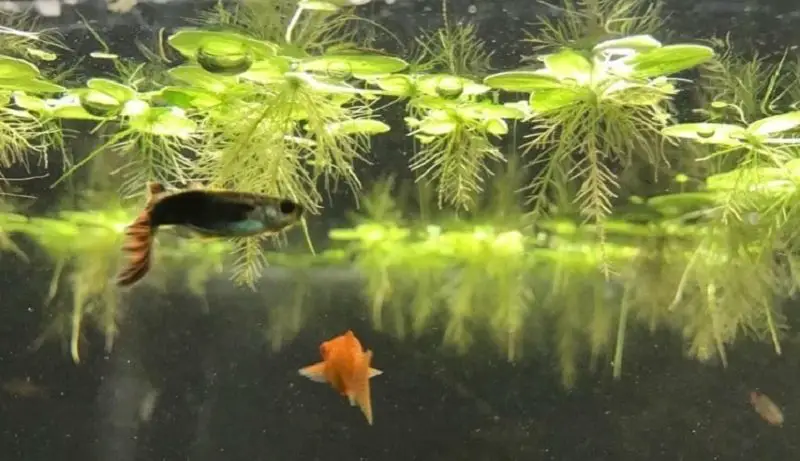
If you decide you want to include water lettuce in your aquarium community, here are a few tips for incorporating them. Please note that it may take the Dwarf water lettuce plants a few days to acclimate to the new environment in your aquarium.
Quarantine
As you must with any new tank addition, the Dwarf water lettuce has to be quarantined before you can add them to your established community.
Your beautiful new water lettuce could be carrying creatures that could prey on the inhabitants of your aquarium, or may contain parasites or other unwelcome additions.
Grow Your Own
You could try to breed your own Dwarf water lettuce. These floaters can breed in two ways: sexually or asexually. In your home aquarium, the latter method is more common.
Sexual reproduction: (less common) The middle of the Dwarf water lettuce has tiny flowers (remember we said they are usually hidden by leaves?). These flowers are either female or male and after successful fertilization through cross-pollination, small berries with greenish seeds appear.
The seed in the berry becomes a new mat on the tank surface.
Asexual reproduction: (more common) Much more likely in a tank set, in asexual reproduction, the small daughter lettuce floats next to the mother plant, attaching to the mother with a stolon (a type of stem).
This is a much quicker process, as the mother/daughter replicating process repeats itself rapidly, forming thick mats of new water lettuce right away and covering the surface of the tank.
Troubleshooting
Having issues with your Dwarf water lettuce plants? Here are some common concerns that aquarium hobbyists raise.
Shrinking or discolored leaves
Both too much light and not enough light might be the culprits if your leaves change color or are getting smaller.
Remember that the Dwarf water lettuce does not like direct light, whether it is natural or bulb light. However, if you have a cover on your tank, your plant might be starving from lack of light, so it is important to assess the lighting situation in your particular case.
Additionally, when the leaves get old, their hue may change to yellow; it’s fine to remove these yellowing leaves from the bottom of the plant.
Shedding of Roots
If your water lettuce is shipped to your home, the roots may seem a little squished or drooping. They’ll grow back quickly, and it’s fine to trim some of the bottoms of the root, as long as you leave at least 4 inches (10.2 cm).
Poor Growth
Less than ideal water situations are likely the cause of a Dwarf water lettuce plant failing to thrive. Check the water pH, temperature, and nutrient level.
Over Growth
We have discussed the importance of disrupting the growth process of Dwarf water lettuce in great detail. In addition to the water lettuce sucking up all the nutrients that other tank inhabitants need, if the lettuce mat covers the whole surface of your aquarium, there are two other important considerations:
- Labyrinth breathers like bettas, and surface feeder fish, like sardines, have difficulty living in an environment that lacks the surface space they need to thrive
- The vegetation on the bottom of the aquarium is in extreme danger if they are unable to access the light they need to survive
Mosquitos
If you see unwanted mosquitos in your tank, the Dwarf water lettuce may be the culprit. The hairs on the plant’s leaves (yes, the same hairs that create the buoyancy that enables floatation) are also a popular nesting surface for mosquitos. As you are doing your weekly routine cleaning, check for mosquito larvae hiding out in the water.
Toxicity Concerns
Although the calcium oxalate crystals that are abundant in Dwarf water lettuce leaves are not usually toxic to fish (except in large quantities), the crystals are poisonous to pets and children, so make sure that they are kept out of reach of snackers who may not know the danger of eating the leaves.
Are Dwarf Water Lettuce Plants Right for your Aquarium?
Although Dwarf water lettuce comes with some pretty significant warning labels, their beautiful appearance adds a great aesthetic to an aquarium community and can also contribute to a healthy tank environment.
Before you invest in one, make sure that you check the legal restrictions regarding the Dwarf water lettuce plant in the area where you live. If they are prohibited, you will need to look for a different plant for your community.
Are Dwarf water lettuce plants worth the effort for your community tank? Let us know why in the comments below!

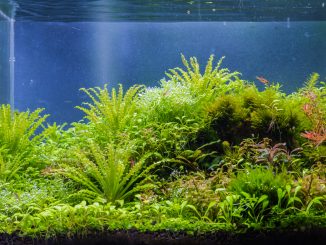
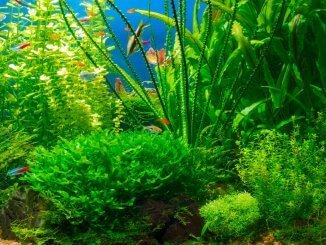
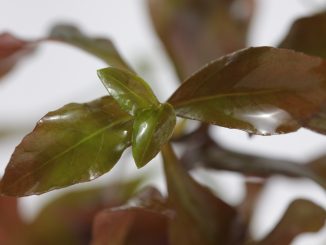
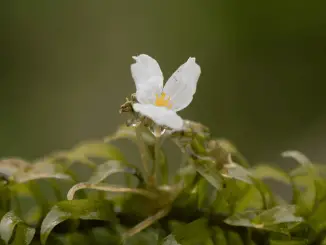
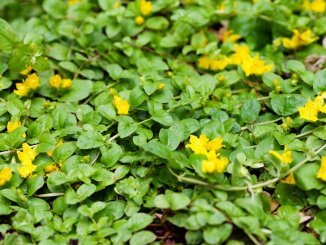
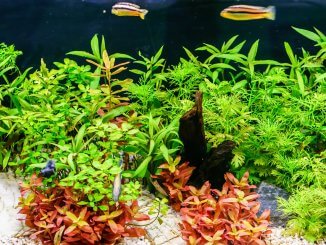
Would I be able to grow this in a 20 gallon deep tank?
I have four betta fish…
The tank is not in direct sunlight but I do keep the light on in the tank for my fish during the day.
Would this be too much light for the water lettuce.
Should I be concerned about bringing diseases into the tank with this plant?
I had a beautiful supply of dwarf water lettuce in my betta tank. It has started dying. The leaves get yellow, small and mushy. The roots have bright bluish green algae on them. Any suggestions? Is this algae bad for my tank?
Thank you!!!
probably way late, but the blue-green algae is probably cyanobacteria, a photosynthetic bacteria which is bad for plants and needs to be gotten rid of if possible. I got mine under control with daily rounds of manual removal (peeling off initially then using a turkey baster type device for any regrowth bits), some use antibiotics though this can crash your biofilter, I’ve heard rave reviews about UltraLife Blue-Green Slime Stain Remover which you can find on Amazon.